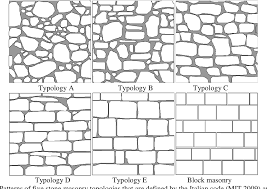Stone masonry, also known as stonecraft, is an ancient profession and one of the oldest human activities. It can be traced back to the ancient Egyptians and Greeks. Thousands of years ago, humans would sift rocks and cut them into blocks. As a result, the craft has evolved through the ages and evolved into an extremely sophisticated form of construction. Read on to learn more about the advantages and disadvantages of Stone Masonry.

Bricks made of flint stone are typically rectangular and stacked one upon the other. Bricks made of these stones are sometimes layered to create more interesting effects. Bricks are a common material for stone masonry, but they can also be made of other materials, such as concrete, brick, and even concrete. Flintstone, for example, is a common stone used in masonry and is a relatively hard, silica stone. Bricks and buildings made of this stone are incredibly dense and may be over 100 cubic meters.
Stone masonry requires a precise selection of stones and a great deal of labor. Unlike concrete, the compressive strength of the stone is almost always greater than that of bricks or other materials. Despite this, stone masonry still needs mortar, which is weaker than stone. Moreover, weathering, freeze-thail expansion, and chemical reactions can damage stone masonry. For this reason, it is best to use cement-based mortars for stone masonry.
In the early part of the 20th century, stone masonry began to undergo dramatic changes. While stone masons had to use human muscle power and draft animals, modern tools helped to simplify their work. The use of forklifts and cranes made it easier to move heavy stones and lay them, and the introduction of motor-powered mortar mixers and compressed-air tools reduced the labor-intensive task of working stones. Similarly, electric and petrol-powered abrasive saws made stone work much faster.
Another variation of stone masonry is known as ashlar masonry. The stone is shaped into irregular polygons. The mortar used to build ashlar masonry is typically thick, requiring highly skilled labor. It is a costly and time-consuming technique, but it creates a strong bond between stones. However, it is an attractive form of masonry, and it requires a high level of craftsmanship. And the cost is high as it requires highly trained labor.
When building a stone-masonry structure, the choice of stone is critical. A wise choice will depend on the type of stone you choose, the availability of natural stones, and the desired effect of the structure. Common stones used for stone masonry include limestone, granite, and marble. In addition to the stone itself, the type of mortar used for stone-masonry construction will depend on the color of the stone, the strength of the structure, and the load that the structure will be subjected to.
The cheapest form of stone masonry is known as rubble masonry. It consists of stone blocks cut directly from the quarry and laid one on top of the other. These stones are cut into distinct shapes and sizes. These stones are laid with the larger ones first, and then the smaller ones. The technique is also known as dry rubble masonry because it does not use a mortar and is used to build earthen dams and pitch canal slopes.
Compared to brick and concrete masonry, stone masonry is durable and requires a strong bond. Stones should be evenly spaced, and the stone joints should be at least 12 mm thick. In addition to this, masonry work isn’t done in layers, but in multiple courses, using stones with different heights will make them stronger. Moreover, they should not overlap by more than 15 cm. This is because this type of stone masonry involves the overlapping of stones.
Another type of stone masonry is uncoursed rubble masonry. It is the cheapest type of stone masonry. The stones used in random rubble masonry are of different shapes and sizes. The stones are knocked off their corners before lying. Joints are not plumbed or filled. Large stones are used at the corners and jambs. Through stone is used for joining faces and sides. If you are unsure about the difference between stone and mortar masonry, check out this guide.
Coursed rubble masonry is one of the most common types of stone masonry. It is typically used in residential and public buildings and has a variety of applications. The height of the stones varies from 5 to 20 cm, and the mortar joints should be at least 10 mm thick. Depending on the size of the stones and the depth of mortar, these masonry types may not be structurally sound. The strength of this type of stone masonry depends on how often it is used and the quality of the mortar.